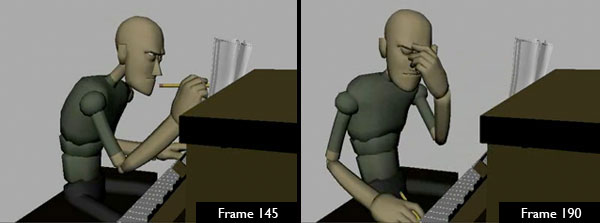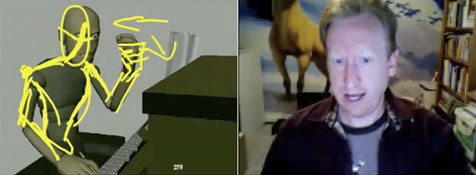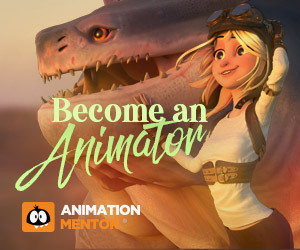Kevin Rucker
Interview conducted by Eric Scheur
One of the biggest challenges in animation is performing a scene that's reserved yet still contains gripping emotion. This month's sound clip called for a character whose rage was bubbling just below the surface; one forum member even noted how often the word "subtle" was used in the voting comments.
I think that when we say "subtle," we are often talking about animation that is concentrated less in the body, and more in the emotion that the face can express. So much can be communicated through the eyes and the brows. Beyond that, there is a lot to be said for how a character uses their mouth when they aren't speaking.
I really enjoyed seeing the way this month's winner, Kevin Rucker, held his character's jaw clenched tight and used the lips to convey the tension and inner-conflict of remaining true to his art while being answerable to someone in a superior position. It's a conflict anyone in a creative field can sympathize with.
-Eric Scheur
How long have you been animating?
Kevin Rucker: I'd say that I've been animating for about 3 years professionally, not including college. Kinda sappy, but I wanted to work for Disney since I was in junior high so I went to the Academy of Art University to study illustration/traditional animation.
After realizing that I didn't enjoy drawing that much and I wasn't that great at it, I decided to take Maya class electives. I knew I wanted to animate so I didn't bother learning modeling and set up, instead I used existing rigs and just concentrated on learning how to animate in the computer. But I am really glad I did take drawing classes and traditional animation courses.
What is your experience in animation?
My experience in animation has been in games so far starting at Sony in Foster City on the cinematics team. After a very short time there I was laid off and soon got a job at The Collective where I learned a great deal from the lead animator on basic principles and how to use reference to help guide my work.
I'm now employed at Ready At Dawn Studios where we just shipped God of War: Chains of Olympus for PSP!! That was a crazy experience. I was able to work on some cool characters and over the top moves. Here I was able to use what I learned from watching reference and apply it to moves you just can't shoot reference for like climbing all over a cyclops and taking it down.
What are your goals as an animator?
To get as good as I can get and to always push myself to do something new. Have I done this before? How else can I approach this that will make it different from this other one? Also, I'm still in the early stages of my career. I'd like to get into film effects and features someday, but I'm really enjoying what I'm doing now and want to see how far I can go.
Where do you find inspiration as an animator?
I think people-watching is fun to do. My wife and I are Disneyland nuts and since we are only, like, 15 minutes away and have season passes, sometimes we'll go and just sit on a bench eating some Gibson Girl ice cream and watch people walk by.
I also go on the BBC Motion Gallery for reference at work and will come across some really cool movies. I saw this pole vault movie the other day and was totally geeking out because the girl, after clearing the top bar, had this awesome line of action to where her arms looked like they were bending like the old Mickey Mouse cartoons!
Talk about your animation process.
Like a lot of people, I listen to the audio loop over and over and over and over. I close my eyes and try to feel what the person in the audio is feeling. Not even what they're saying but how they are saying it.
This is where I make sure no one can see me: I try and act out what I'm feeling with the audio still looping. Sometimes I'll shoot reference but most of the time I'll just draw one or two thumbnails of just the main points or attitudes. For this one it was the frustrated hand on face pose and upset looking at pencil pose.
Then I go in the computer and start blocking in my animation working in stepped curves. I also add hand/finger poses and eyes/brows right from the beginning, it helps he see the attitude of the character. If I could draw better, I'd do this on paper, but working in games I've learned to be fast. I can plan and act it out all day and imagine what it will look like, but until I see the character moving [I won't] know if it's working or not.
What did you hear in the actor's voice that inspired the performance?
I imagined him in the moment of his frustration, instead of him recalling the incident. With those pauses, I thought right away of him looking at something; instrument/sheet music. I wanted to get across that he's upset that the director edited his music and almost feels trapped because it was perfect when he made it.
Talk a bit about the decision to add a little silence before the audio clip began.
Again, it goes back to wanting him to be in the moment. I wanted to show that he's trying to put together and play this music that we find out a director has edited. He's frustrated and certain that it was just right before anyone touched it, and we see in the beginning that's he's giving it a shot.
There was a great sense of angst and frustration in your character. Did you draw upon any personal experiences for the emotions animated?
Haha! I think we all have felt proud of some of our work then it gets a thrown out or needs to get redone.
Did you get advice from anyone while animating this piece?
I wish I did on this one. I have a good friend from college I usually run every frame by, but for one reason or another I did this on my own. I showed some people at work, but I didn't really get a ton of crits on it.
I did spend some time with my blocking stage and started over a couple times. I think since I didn't have any help I tried to stay extra critical.
Did you find yourself struggling with any part of the animation?
Yes, a thousand times yes. I had a doozie of a time trying to come of with a frustrating attitude. I knew I wanted one camera and I wanted to stay really simple and low key on the movements.
I had the right hand forward pose at 145 and the hand on head pose at 190 in the beginning, I tried several transitions between the two.

And at the second sigh around frame 300 onward, I tried a bunch of stuff. I had more head turns, less head turns. Does he look right/left, left/right? When do I bring his hand back off his thigh? I didn't want his arms to move around for no reason. Why is his hand falling on his leg? Why would he bring it back up? I liked the idea of him looking at his pencil, like he's thinking, 'I can't possibly use this anymore than I already have'. But when does he look at it? When does he look away?

Man, so many different chooses to make, tough to go with just one.
What was your initial reaction to the eCritique?
A big 'ol smile. I just watched Nightmare Before Christmas a couple days ago and was thinking of the immense skill it takes to animate frame by frame like that and look who's doing my critique!!
Talk about any new concepts you were introduced to through the eCritique.
 Well this isn't new, but I agree I need to push it more. I played it safe trying to keep it simple, but it can still be simple with pushed poses.
Well this isn't new, but I agree I need to push it more. I played it safe trying to keep it simple, but it can still be simple with pushed poses.
Having the character grab and slap the music but then 'oh, my poor music', was great. Good ideas are tough to come up with. It's awesome how he can see past all the offset finger junk and polish and look at the essence of the pose and gesture.
Do you intend to return to this piece to incorporate the suggestions made in the eCritique?
I'd like to. There are things I know to do like the character thinks then acts, but it's hard to think of everything all the time. There's nothing like a good, solid, black and white critique to help plus your work. I wish I would have done that before hand like I do with my other work.
Is there anything else you'd like to say to the members of the 11 Second Club community?
Don't give up and don't be afraid to start over if you need to. Don't take crits personally. Try to evaluate why the person is suggesting a change instead of just changing it so you can learn and apply that to your next thing. Find the difference between making it better or just different. Mike was great because he had a reason behind his suggestions. There was a clear line between plusing and a change just to try something different.
Also, thanks Mike for your time with my work!
Discuss this interview in the forums
comments powered by Disqus






